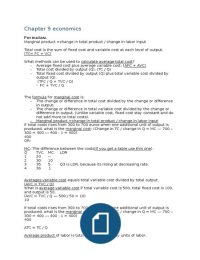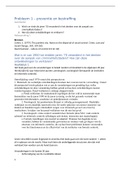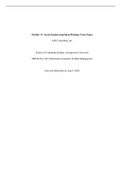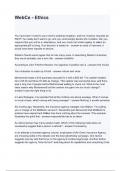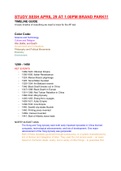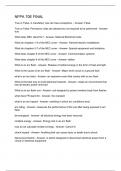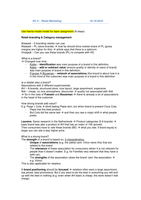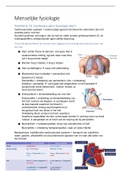Chapter 9 economics
Formulas:
Marginal product =change in total product / change in labor input
Total cost is the sum of fixed cost and variable cost at each level of output.
(TC= FC + VC)
What methods can be used to calculate average total cost?
- Average fixed cost plus average variable cost; (AFC + AVC)
- Total cost divided by output (Q); (TC / Q)
- Total fixed cost divided by output (Q) plus total variable cost divided by
output (Q).
(TFC / Q + TVC / Q)
- FC + TVC / Q
The formula for marginal cost is:
- The change or difference in total cost divided by the change or difference
in output;
- The change or difference in total variable cost divided by the change or
difference in output. (Unlike variable cost, fixed cost stay constant and do
not add more to total costs).
- Marginal product =change in total product / change in labor input
If total costs rises from 300 to 700 euros when one additional unit of output is
produced, what is the marginal cost: (Change in TC / change in Q = MC --- 700 –
300 = 400 --- 400 : 1 = 400)
400
OR:
MC: The difference between the costs(if you get a table use this one).
Q TVC MC LDR
1 20 --
2 30 10
3 35 5 Q3 is LDR, because its rising at decreasing rate.
4 36 1
Averages variable cost equals total variable cost divided by total output.
(AVC = TVC / Q)
What is average variable cost if total variable cost is 500, total fixed cost is 100,
and output is 50.
(AVC = TVC / Q --- = 10)
10
If total costs rises from 300 to 700 euros when one additional unit of output is
produced, what is the marginal cost: (Change in TC / change in Q = MC --- 700 –
300 = 400 --- 400 : 1 = 400)
400
ATC = TC / Q
Average product of labor is total product divided by units of labor:
, AV = Total product / units of labor
Economic costs = explicit cost + implicit cost.
Accounting profit = total explicit cost – total sales revenue.
Your accounting profit overstates the economic success of your business because
it ignores your implicit costs. Success is not ‘having a total sales revenue that
exceeds total explicit costs’. Measure of success is doing as well as you possibly
can- that making more with what you do now than if you did something
else(implicit cost). Doing so will indicate whether your business is earning more
money than what you could have earned somewhere else.
So at this graph, as long as the middle point of the curves of every 1, 2, 3, 4,5. Is
falling down it is economies of scale. So as you can see at the 4th curve the
middle point is higher than the middle curve of the 3th.
A firm exhibits constant returns to scale as it increase its output over any
reasonable range. If it increases all its inputs by 10% its:
Output will increase by 10%. ( constant returns to scale occur when a
proportional increase in all inputs increases outputs by the same proportion,
leaving average cost unchanged.
Remember explicit and implicit cost are opportunity costs.
The following would short- run cost curves would not be affected by an increase
in the wage paid to a firm’s labor:
AFC(Average fixed cost), because labor is variable resource in the short run, an
increase in the wage increases the firm’s MC(Marginal Cost) and its AVC(Average
Variable cost). AFC(Average Fixed Cost), however depends only on the cost of the
firm’s fixed resources, so will not change. AVC(Average Variable cost)must
increase because of the increase in AVC(Average Variable cost) coupled with the
unchanging AFC.
If marginal product is positive but falling:
Total product is increasing at a decreasing rate.
MP is the increase in output attributable to the employment of another worker. If
this is positive, output(TP) must be increasing. However since MP is diminishing,
Formulas:
Marginal product =change in total product / change in labor input
Total cost is the sum of fixed cost and variable cost at each level of output.
(TC= FC + VC)
What methods can be used to calculate average total cost?
- Average fixed cost plus average variable cost; (AFC + AVC)
- Total cost divided by output (Q); (TC / Q)
- Total fixed cost divided by output (Q) plus total variable cost divided by
output (Q).
(TFC / Q + TVC / Q)
- FC + TVC / Q
The formula for marginal cost is:
- The change or difference in total cost divided by the change or difference
in output;
- The change or difference in total variable cost divided by the change or
difference in output. (Unlike variable cost, fixed cost stay constant and do
not add more to total costs).
- Marginal product =change in total product / change in labor input
If total costs rises from 300 to 700 euros when one additional unit of output is
produced, what is the marginal cost: (Change in TC / change in Q = MC --- 700 –
300 = 400 --- 400 : 1 = 400)
400
OR:
MC: The difference between the costs(if you get a table use this one).
Q TVC MC LDR
1 20 --
2 30 10
3 35 5 Q3 is LDR, because its rising at decreasing rate.
4 36 1
Averages variable cost equals total variable cost divided by total output.
(AVC = TVC / Q)
What is average variable cost if total variable cost is 500, total fixed cost is 100,
and output is 50.
(AVC = TVC / Q --- = 10)
10
If total costs rises from 300 to 700 euros when one additional unit of output is
produced, what is the marginal cost: (Change in TC / change in Q = MC --- 700 –
300 = 400 --- 400 : 1 = 400)
400
ATC = TC / Q
Average product of labor is total product divided by units of labor:
, AV = Total product / units of labor
Economic costs = explicit cost + implicit cost.
Accounting profit = total explicit cost – total sales revenue.
Your accounting profit overstates the economic success of your business because
it ignores your implicit costs. Success is not ‘having a total sales revenue that
exceeds total explicit costs’. Measure of success is doing as well as you possibly
can- that making more with what you do now than if you did something
else(implicit cost). Doing so will indicate whether your business is earning more
money than what you could have earned somewhere else.
So at this graph, as long as the middle point of the curves of every 1, 2, 3, 4,5. Is
falling down it is economies of scale. So as you can see at the 4th curve the
middle point is higher than the middle curve of the 3th.
A firm exhibits constant returns to scale as it increase its output over any
reasonable range. If it increases all its inputs by 10% its:
Output will increase by 10%. ( constant returns to scale occur when a
proportional increase in all inputs increases outputs by the same proportion,
leaving average cost unchanged.
Remember explicit and implicit cost are opportunity costs.
The following would short- run cost curves would not be affected by an increase
in the wage paid to a firm’s labor:
AFC(Average fixed cost), because labor is variable resource in the short run, an
increase in the wage increases the firm’s MC(Marginal Cost) and its AVC(Average
Variable cost). AFC(Average Fixed Cost), however depends only on the cost of the
firm’s fixed resources, so will not change. AVC(Average Variable cost)must
increase because of the increase in AVC(Average Variable cost) coupled with the
unchanging AFC.
If marginal product is positive but falling:
Total product is increasing at a decreasing rate.
MP is the increase in output attributable to the employment of another worker. If
this is positive, output(TP) must be increasing. However since MP is diminishing,


